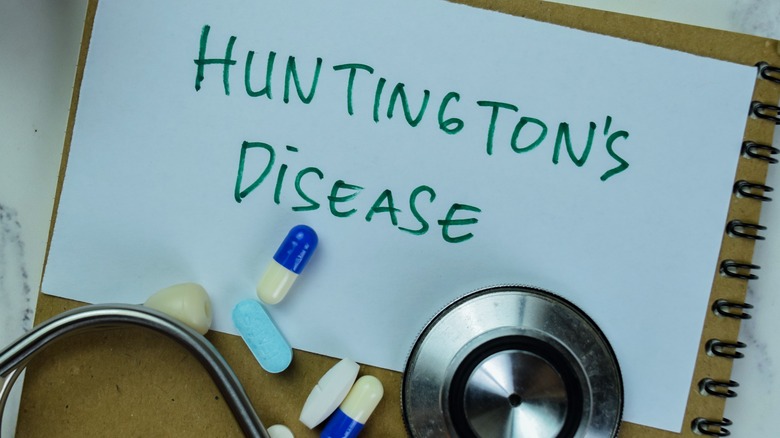Symptoms Of Huntington's Disease You Shouldn't Ignore
Huntington's disease is a rare genetic disorder that affects only a small percentage of the world's population, according to Fondazione LRH. It is a neurological condition that primarily involves the nervous system. The damage is cumulative, resulting in various symptoms that can make daily life difficult. The genetic component was discovered in 1993 and linked to the HTT gene, which produces abnormal proteins that destroy specific neurons in the brain.
Individual symptoms of Huntington's disease can vary due to the progression and destruction of neurons. Furthermore, symptoms are frequently misdiagnosed as other conditions, making it critical to be aware of the signs and seek medical attention if they are suspected.
Even though this condition is uncommon, help and information are readily available. Early detection is essential for obtaining appropriate treatment and support. Although there is no cure, understanding the symptoms of Huntington's disease enables you to take action to manage the disease and maintain a high quality of life (via Huntington's Disease Association).
Early symptoms of Huntington's disease can be difficult to detect
Early symptoms of Huntington's disease can be subtle and difficult to detect. Furthermore, symptoms may mimic other disease processes or appear annoying without a real explanation. As a result, diagnosing a patient at first can be difficult, so it is critical to recognize these early warning signs, especially if you have a family history of the disease (via Huntington's Disease Association).
Some early warning signs may include changes in movement, such as clumsiness or difficulty with coordination. Mild chorea is a type of involuntary movement that is not controllable. In addition, mild cognitive impairment (such as difficulty with memory, concentration, and decision-making) may present. Finally, behavioral and mood symptoms such as depression, irritability, and impulsivity can occur.
Huntington's disease symptoms may appear later in life and may be more severe in certain groups of people. According to Medical News Today, these symptoms can be confused with those of other conditions, such as Parkinson's disease, dementia, or mental health conditions. Therefore, it's important to be aware of them and seek medical attention if they're suspected.
Early detection of Huntington's disease can slow progression
Early detection of Huntington's disease enables the patient to receive appropriate treatment and support. The earlier a diagnosis is made, the more effective treatment for symptom management and disease progression can be. According to a study published in Future Neurol, early diagnosis helps patients with Huntington's disease and their families to plan for the future and make medical and legal decisions. However, it has been argued that identifying specific indicators of the disease years before an official diagnosis may cause untoward responses, including stress, discrimination, and other potential risks.
HCP Live reported that United Kingdom researchers found a blood test to detect early signs of Huntington's disease. This discovery is progress in the right direction, as it can decipher who will develop Huntington's disease. However, it cannot determine when and what symptoms may present. The hope is to discover medications that can slow the progression of the disease.
Currently, there is no cure for Huntington's disease, and treatment is primarily focused on managing the symptoms and slowing the progression of the disease. This further emphasizes that early diagnosis is essential for long-term outcomes. Additionally, medications can be prescribed to manage movement, cognitive, and mood symptoms. Other therapies, such as physical therapy, occupational therapy, and speech therapy, may also be helpful.
Movement symptoms you shouldn't ignore
Uncontrolled movement is one of the most distinguishing symptoms of Huntington's (via the National Institute of Neurological Disorders and Stroke). As the disease progresses, other symptoms such as muscle stiffness may become more prominent. Involuntary movements are referred to as chorea, and may present as clumsiness, jerking, twitching, or restlessness in appearance. In addition, these "sudden, unintended, and uncontrollable" movements can affect the limbs, facial muscles, and eyes. When this happens, it can become difficult to perform activities of daily living such as eating, getting dressed, writing, or driving.
In addition to chorea, individuals with Huntington's disease may also experience dystonia, a type of muscle spasm that can manifest in various degrees of severity and impact one or more areas of the body depending on symptoms (via Mayo Clinic). These symptoms can lead to difficulty with balance and coordination, making it hard to walk or stand. In most cases, pain is not a concern. However, if the neck is impacted, it can be painful and cause chronic headaches. In addition, as the disease progresses, the movement symptoms can become even more severe, leading to disability (per the American Association of Neurological Surgeons).
What happens when a child gets Huntington's disease?
According to the Cleveland Clinic, Huntington's disease is rare in adults, but even more uncommon in children. The genetic condition affects approximately 30,000 people in the United States, with children accounting for up to a tenth of those affected.
The progression of Juvenile Huntington's disease (JHD) is more rapid than that of adult-onset. According to the Huntington's Disease Society of America, the earlier a person is diagnosed, the faster the disease worsens. When it occurs in children, death usually occurs within a decade of the diagnosis. Children's most likely symptoms include clumsiness, behavioral changes, leg stiffness, and a decreased ability to think critically.
The National Center for Advancing Translational Sciences reported that most children inherit this gene from their fathers rather than their mothers. If the father is known to have the gene, consult with a healthcare provider immediately about family health management.
Cognitive symptoms of Huntington's disease
According to a study published in Neurology and Neuroscience Reports, one of the most incapacitating features of Huntington's disease is cognitive decline. This can begin to manifest up to 15 years before motor function impairments. In the early stages of Huntington's disease, patients may experience mild cognitive impairment, including symptoms such as memory loss, difficulty concentrating, and the inability to make decisions.
Furthermore, the individual may struggle with paying attention or focusing on tasks (via HDSA). These symptoms may be misdiagnosed as normal aging, but cognitive abilities deteriorate as the disease progresses. Memory loss, attention deficits, and difficulty making decisions worsen and can mimic dementia. As a result, it is difficult for people with Huntington's disease to carry out daily tasks and maintain social and occupational functioning.
People with Huntington's disease may face challenges with task planning, organization, task completion, and abstract thinking. This impairment is a significant life-altering event for the individual and their family, as the affected person will begin to have a decline in their interactions with others, as well as their ability to maintain relationships and continue their careers.
Behavioral and mood symptoms of Huntington's disease that can be disrupting
Huntington's disease can also impact a person's behavior and emotional well-being. Although behavioral symptoms vary, there are specific parts of the brain, specifically the caudate nucleus, where damage is most prevalent. Therefore, Huntington's disease damages result in various expected behavioral changes (per Stanford University).
Furthermore, the university reports that brain damage affects how different parts of the brain communicate with one another. When the normal communication pathway is disrupted, logical thinking suffers because the message is not delivered to the brain's rational part. As a result, common behavioral symptoms may include lethargy, depression, anxiety, irritability, and apathy (per a study published in Neuropsychiatry, Neuropsychology, and Behavioral Neurology). If these behaviors begin to disrupt life, there is treatment available that may help reduce the symptoms, such as medications for depression or counseling (via Huntington's Disease News).
Aggression is another behavioral component — a research study reported that up to 66% of people with Huntington's had episodes of aggression. Additionally, it was found to be of higher incidence in the male population. Medications may help curb the aggression, so it is essential to speak with a healthcare provider if this symptom is evident.
If you or someone you know needs help with mental health, please contact the Crisis Text Line by texting HOME to 741741, call the National Alliance on Mental Illness helpline at 1-800-950-NAMI (6264), or visit the National Institute of Mental Health website.
Progression of Huntington's disease
Huntington's disease is a progressive illness that does not have a cure. Symptoms may start mild, but will worsen with time. According to the Huntington's Disease Society of America, the symptoms can be divided into three main stages. The first stage is marked by minor symptoms that can be mistaken for other conditions and may go undiagnosed or be noticed as needing medical attention. In this stage, the individual can still work and perform everyday tasks. However, they may experience signs of involuntary movements, disruption in normal thought processes, and potential mood changes, such as depression.
As the disease progresses, the person will enter stage two, where they will gradually be unable to think clearly, limiting their capacity to complete tasks such as managing money, keeping a job, or making financial decisions. Furthermore, motor skills and balance may impede this stage. At this point, the individual may require assistance from family or a caregiver for certain day-to-day tasks.
Finally, the third or late stage is when you will see a significant decline in the ability to care for oneself. Motor skills are severely impaired at this stage, and psychiatric disorders may be prominent due to the inability to communicate effectively.
Huntington's disease is often misdiagnosed
Because Huntington's disease is rare, its symptoms can be misinterpreted as other diseases. Early signs of Huntington's disease, such as mild chorea, cognitive impairment, and behavioral and mood symptoms, can be confused with those of other conditions, making diagnosis difficult (via Hindawi). For example, Huntington's disease movement symptoms can be mistakenly diagnosed as Parkinson's disease or essential tremor. Cognitive symptoms may mimic dementia, while behavioral and mood symptoms could send you to a psychiatrist for a consultation for depression, anxiety, or bipolar disorder.
Furthermore, a study published in Case Reports of Psychiatry reported that some Huntington's disease symptoms may be more severe in the aging population, and could be disregarded as symptoms of other more common conditions in those groups, leading to years of misdiagnosed symptoms. For example, Huntington's disease symptoms may be hastily concluded as symptoms of age-related cognitive decline in older adults. They are often misinterpreted as depression, anxiety, or other mental health illnesses and can take years to diagnose accurately. This is especially true if the individual's ancestors were misdiagnosed, and they are unaware of the genetic predisposition of the disease.
These symptoms may not appear until later in life, and can mislead your healthcare provider to a wrong diagnosis. For this reason, it is imperative to inform your healthcare team of any family history of Huntington's disease so that symptoms can be diagnosed accurately.
Uncovering the prevalence and risk factors of Huntington's disease
Over 41,000 Americans are diagnosed with Huntington's disease. While this number may seem small compared to the population, it is still concerning, as these people will inevitably pass down this genetic trait to other family members (via Huntington's Disease Society of America). Because Huntington's is inherited in an autosomal dominant pattern, a person has a 50% chance of inheriting the disease if one of their parents has it. However, on a positive note, if the gene does not pass down from the parent, the person will not pass it on to their offspring.
The highest frequency of Huntington's disease is found in populations of European descent. According to MedlinePlus, up to seven out of 100,000 people with this lineage are affected by this rare genetic mutation. On the other hand, Japanese, Chinese, and African cultures have lower incidences of developing Huntington's.
Various genetic testing options are available for people with a family history of Huntington's disease, which can help them understand their risk of developing the disorder and make informed decisions about their health (via HDGenetics).
Tap into available resources for Huntington's disease patients
Patients, caregivers, and families must utilize the many resources available to help them cope with and manage the progression of the disease. Support from others who are also affected by the same illness can be valuable.
The National Youth Alliance program of the Huntington's Disease Society of America (HDSA) empowers adolescents with Huntington's disease by raising awareness about the condition and creating support groups for them across the country. By participating in this program, children affected by the disease can access resources that provide a safe space to express their emotions and connect with others facing similar challenges. They can also get involved in various activities that "not only support young people within the HD community, but also inspire [them] to get involved in the battle against HD."
In addition to youth support, the HDSA offers programs for adults with various resources for caregivers and patients alike, including social networking opportunities, access to social workers, and telehealth consultations.











